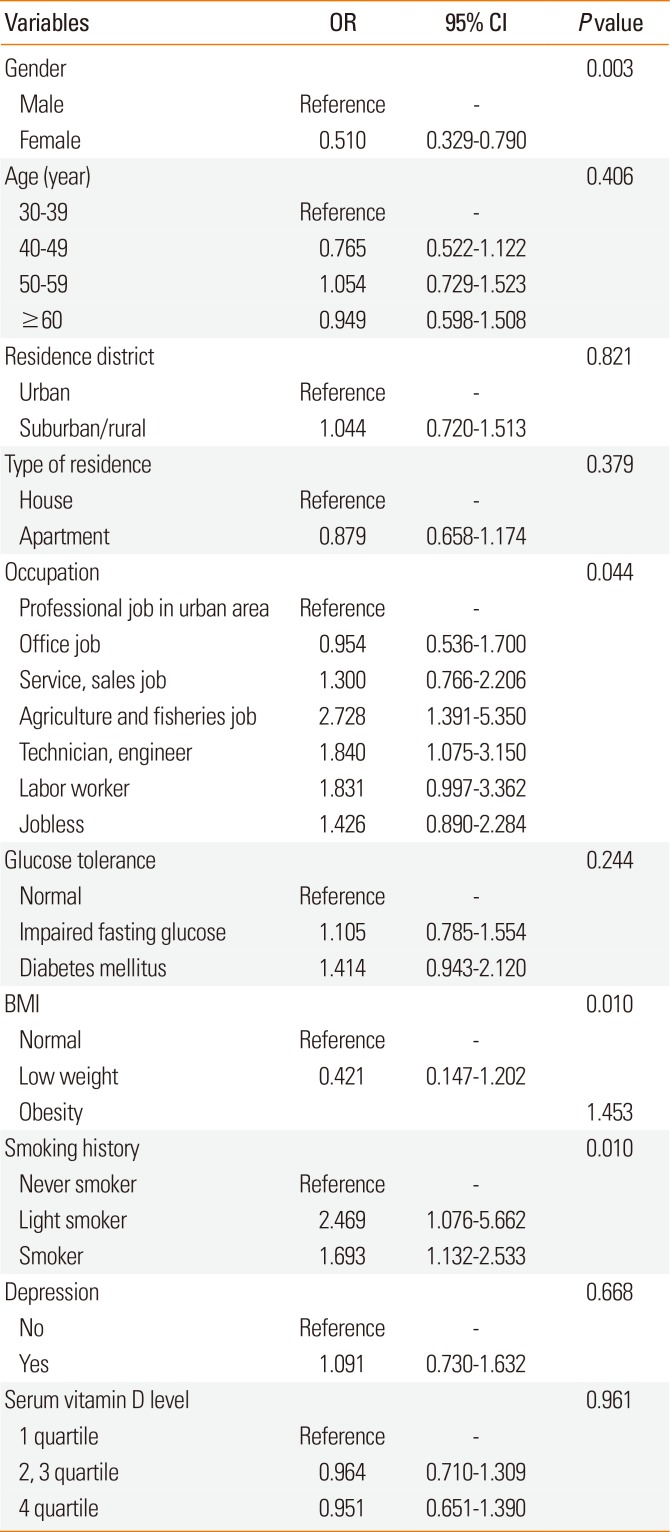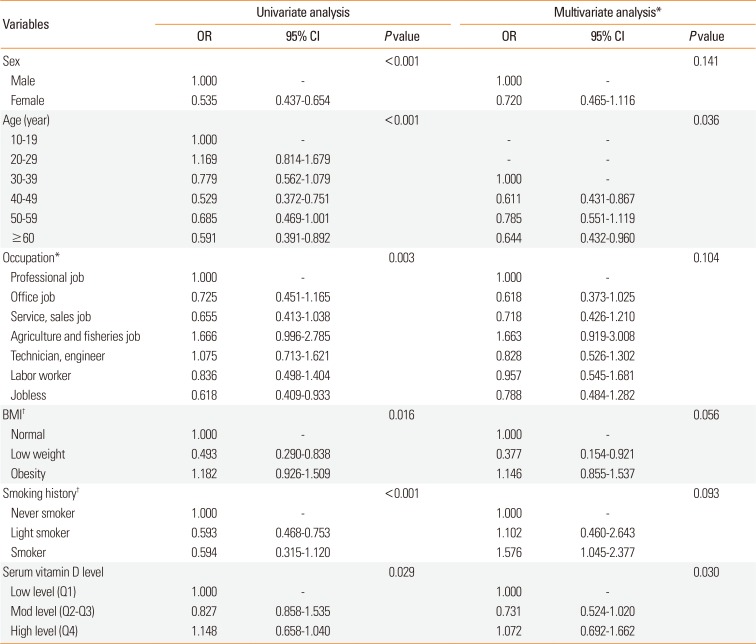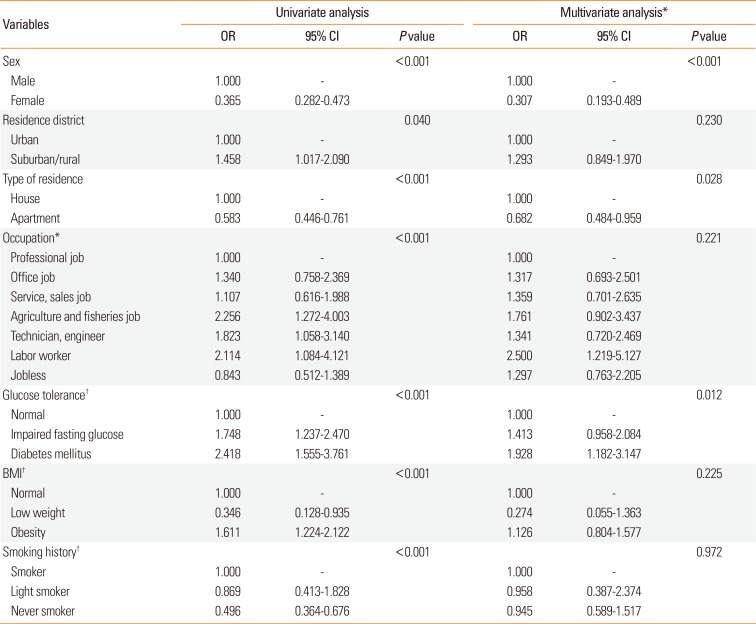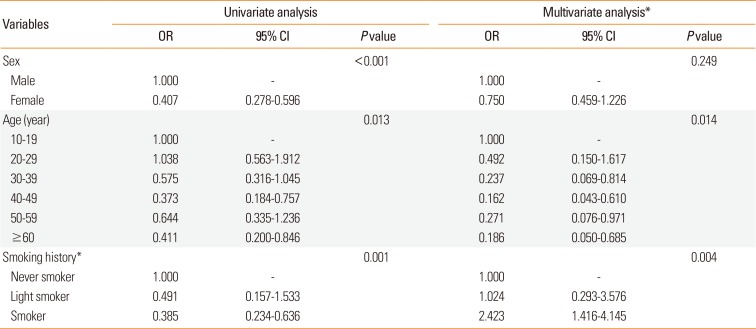1. Larsen FS, Holm NV, Henningsen K. Atopic dermatitis. A genetic-epidemiologic study in a population-based twin sample. J Am Acad Dermatol. 1986; 15:487–494. PMID:
3760273.

2. Sicherer SH, Furlong TJ, Maes HH, Desnick RJ, Sampson HA, Gelb BD. Genetics of peanut allergy: a twin study. J Allergy Clin Immunol. 2000; 106:53–56. PMID:
10887305.

3. Liu X, Zhang S, Tsai HJ, Hong X, Wang B, Fang Y, et al. Genetic and environmental contributions to allergen sensitization in a Chinese twin study. Clin Exp Allergy. 2009; 39:991–998. PMID:
19302247.

4. Campbell DE, Boyle RJ, Thornton CA, Prescott SL. Mechanisms of allergic disease - environmental and genetic determinants for the development of allergy. Clin Exp Allergy. 2015; 45:844–858. PMID:
25772780.

5. Ariano R, Berra D, Chiodini E, Ortolani V, Cremonte LG, Mazzarello MG, et al. Ragweed allergy: pollen count and sensitization and allergy prevalence in two Italian allergy centers. Allergy Rhinol (Providence). 2015; 6:177–183. PMID:
26686209.
6. Park HJ, Lee JH, Park KH, Kim KR, Han MJ, Choe H, et al. A six-year study on the changes in airborne pollen counts and skin positivity rates in Korea: 2008-2013. Yonsei Med J. 2016; 57:714–720. PMID:
26996572.

7. Song Y, Wang M, Xie J, Li W, Zhang X, Wang T, et al. Prevalence of allergic rhinitis among elementary and middle school students in Changsha city and its impact on quality of life. J Laryngol Otol. 2015; 129:1108–1114. PMID:
26391176.

8. Lusi EA, Di Ciommo VM, Patrissi T, Guarascio P. High prevalence of nickel allergy in an overweight female population: a pilot observational analysis. PLoS One. 2015; 10:e0123265. PMID:
25822975.

9. Han YY, Forno E, Gogna M, Celedón JC. Obesity and rhinitis in a nationwide study of children and adults in the United States. J Allergy Clin Immunol. 2016; 137:1460–1465. PMID:
26883461.

10. Niruban SJ, Alagiakrishnan K, Beach J, Senthilselvan A. Association between vitamin D and respiratory outcomes in Canadian adolescents and adults. J Asthma. 2015; 52:653–661. PMID:
25563060.

11. Kim Y. The Korea National Health and Nutrition Examination Survey (KNHANES): current status and challenges. Epidemiol Health. 2014; 36:e2014002. PMID:
24839580.

12. Chun YH, Han K, Park YG, Yoon JS, Kim HH, Kim JT, et al. Examining impacts of allergic diseases on psychological problems and tobacco use in Korean adolescents: the 2008-2011 Korean National Health and Nutrition Examination Survey. PLoS One. 2015; 10:e0125172. PMID:
25897790.

13. Lu Y, Mak KK, van Bever HP, Ng TP, Mak A, Ho RC. Prevalence of anxiety and depressive symptoms in adolescents with asthma: a meta-analysis and meta-regression. Pediatr Allergy Immunol. 2012; 23:707–715. PMID:
22957535.

14. Kim DH, Han K, Kim SW. Relationship between allergic rhinitis and mental health in the general Korean adult population. Allergy Asthma Immunol Res. 2016; 8:49–54. PMID:
26540501.

15. Fukui M, Tanaka M, Hamaguchi M, Senmaru T, Sakabe K, Shiraishi E, et al. Eosinophil count is positively correlated with albumin excretion rate in men with type 2 diabetes. Clin J Am Soc Nephrol. 2009; 4:1761–1765. PMID:
19808222.

16. Park HJ, Lim HS, Park KH, Lee JH, Park JW, Hong CS. Changes in allergen sensitization over the last 30 years in Korea respiratory allergic patients: a single-center. Allergy Asthma Immunol Res. 2014; 6:434–443. PMID:
25229001.

17. Salo PM, Arbes SJ Jr, Jaramillo R, Calatroni A, Weir CH, Sever ML, et al. Prevalence of allergic sensitization in the United States: results from the National Health and Nutrition Examination Survey (NHANES) 2005-2006. J Allergy Clin Immunol. 2014; 134:350–359. PMID:
24522093.

18. Hwang CY, Chen YJ, Lin MW, Chen TJ, Chu SY, Chen CC, et al. Prevalence of atopic dermatitis, allergic rhinitis and asthma in Taiwan: a national study 2000 to 2007. Acta Derm Venereol. 2010; 90:589–594. PMID:
21057741.
19. Vasto S, Malavolta M, Pawelec G. Age and immunity. Immun Ageing. 2006; 3:2. PMID:
16504129.

20. Yao CW, Shen TC, Lu CR, Wang YC, Lin CL, Tu CY, et al. Asthma is associated with a subsequent risk of peripheral artery disease: a longitudinal population-based study. Medicine (Baltimore). 2016; 95:e2546. PMID:
26817901.
21. Kim S, Kim J, Kim K, Kim Y, Park Y, Baek S, et al. Healthcare use and prescription patterns associated with adult asthma in Korea: analysis of the NHI claims database. Allergy. 2013; 68:1435–1442. PMID:
24131085.

22. Kim CY, Park HW, Ko SK, Chang SI, Moon HB, Kim YY, et al. The financial burden of asthma: a nationwide comprehensive survey conducted in the republic of Korea. Allergy Asthma Immunol Res. 2011; 3:34–38. PMID:
21217923.

23. von Mutius E, Vercelli D. Farm living: effects on childhood asthma and allergy. Nat Rev Immunol. 2010; 10:861–868. PMID:
21060319.

24. Smit LA, Heederik D, Doekes G, Lammers JW, Wouters IM. Occupational endotoxin exposure reduces the risk of atopic sensitization but increases the risk of bronchial hyperresponsiveness. Int Arch Allergy Immunol. 2010; 152:151–158. PMID:
20016197.

25. Elholm G, Schlünssen V, Doekes G, Basinas I, Bibby BM, Hjort C, et al. Become a farmer and avoid new allergic sensitization: adult farming exposures protect against new-onset atopic sensitization. J Allergy Clin Immunol. 2013; 132:1239–1241. PMID:
23987793.

26. Prodi A, Rui F, Fortina AB, Corradin MT, Filon FL. Occupational sensitization to epoxy resins in Northeastern Italy (1996-2010). Int J Occup Environ Health. 2015; 21:82–87. PMID:
25633931.

27. Zhao HJ, Cai SX, Tong WC, Li WJ, Fu L. Influence of education level on self-evaluation and control of patients with bronchial asthma. Nan Fang Yi Ke Da Xue Xue Bao. 2008; 28:715–717. PMID:
18504187.
28. Lee KS, Rha YH, Oh IH, Choi YS, Choi SH. Socioeconomic and sociodemographic factors related to allergic diseases in Korean adolescents based on the Seventh Korea Youth Risk Behavior Web-based Survey: a cross-sectional study. BMC Pediatr. 2016; 16:19. PMID:
26819079.

29. Ezeamuzie CI, Al-Ali SF, Al-Dowaisan A, Khan M, Hijazi Z, Thomson MS. Reference values of total serum IgE and their significance in the diagnosis of allergy among the young adult Kuwaiti population. Clin Exp Allergy. 1999; 29:375–381. PMID:
10202346.

30. Paula Couto TA, Falsarella N, Mattos Cde C, Mattos LC. Total IgE plasma levels vary according to gender and age in Brazilian patients with allergic rhinitis. Clinics (Sao Paulo). 2014; 69:740–744. PMID:
25518031.
31. Linneberg A, Petersen J, Nielsen NH, Madsen F, Frølund L, Dirksen A, et al. The relationship of alcohol consumption to total immunoglobulin E and the development of immunoglobulin E sensitization: the Copenhagen Allergy Study. Clin Exp Allergy. 2003; 33:192–198. PMID:
12580911.

32. Song WJ, Chang YS, Lim MK, Yun EH, Kim SH, Kang HR, et al. Staphylococcal enterotoxin sensitization in a community-based population: a potential role in adult-onset asthma. Clin Exp Allergy. 2014; 44:553–562. PMID:
24444125.

33. Lee JY, Yang MH, Hwang JH, Kang M, Paeng JW, Yune S, et al. The prevalence of toxocariasis and diagnostic value of serologic tests in asymptomatic Korean adults. Allergy Asthma Immunol Res. 2015; 7:467–475. PMID:
26122506.

34. Visness CM, London SJ, Daniels JL, Kaufman JS, Yeatts KB, Siega-Riz AM, et al. results from the National Health and Nutrition Examination Survey 2005-2006. J Allergy Clin Immunol 2009. 1169; 123:1163–1169. 1169.e1–1169.e4.
35. Schachter LM, Peat JK, Salome CM. Asthma and atopy in overweight children. Thorax. 2003; 58:1031–1035. PMID:
14645967.

36. Holford-Strevens V, Warren P, Wong C, Manfreda J. Serum total immunoglobulin E levels in Canadian adults. J Allergy Clin Immunol. 1984; 73:516–522. PMID:
6707394.
37. Barbee RA, Halonen M, Kaltenborn W, Lebowitz M, Burrows B. A longitudinal study of serum IgE in a community cohort: correlations with age, sex, smoking, and atopic status. J Allergy Clin Immunol. 1987; 79:919–927. PMID:
3584747.

38. Gupta RS, Lau CH, Hamilton RG, Donnell A, Newhall KK. Predicting outcomes of oral food challenges by using the allergen-specific IgE-total IgE ratio. J Allergy Clin Immunol Pract. 2014; 2:300–305. PMID:
24811021.

39. Grabenhenrich L, Lange L, Härtl M, Kalb B, Ziegert M, Finger A, et al. The component-specific to total IgE ratios do not improve peanut and hazelnut allergy diagnoses. J Allergy Clin Immunol. 2016; 137:1751–1760.e8. PMID:
27087317.
40. Daniluk U, Alifier M, Kaczmarski M, Stasiak-Barmuta A, Lebensztejn D. Longitudinal observation of children with enhanced total serum IgE. Ann Allergy Asthma Immunol. 2015; 114:404–410.e4. PMID:
25747322.

41. Benício MH, Ferreira MU, Cardoso MR, Konno SC, Monteiro CA. Wheezing conditions in early childhood: prevalence and risk factors in the city of São Paulo, Brazil. Bull World Health Organ. 2004; 82:516–522. PMID:
15508196.
42. Satwani H, Rehman A, Ashraf S, Hassan A. Is serum total IgE levels a good predictor of allergies in children? J Pak Med Assoc. 2009; 59:698–702. PMID:
19813686.
43. Kim SH, Yang SY, You J, Lee SB, You J, Chang YS, et al. Association of specific immunoglobulin e to staphylococcal enterotoxin with airway hyperresponsiveness in asthma patients. Tuberc Respir Dis (Seoul). 2016; 79:295–301. PMID:
27790282.

44. Adisesh A, Gruszka L, Robinson E, Evans G. Smoking status and immunoglobulin E seropositivity to workplace allergens. Occup Med (Lond). 2011; 61:62–64. PMID:
21098081.

45. Shargorodsky J, Garcia-Esquinas E, Navas-Acien A, Lin SY. Allergic sensitization, rhinitis, and tobacco smoke exposure and adolescents. Int Forum Allergy Rhinol. 2015; 5:471–476. PMID:
25884913.
46. Kim Y, Park S, Kim NS, Lee BK. Inappropriate survey design analysis of the Korean National Health and Nutrition Examination Survey may produce biased results. J Prev Med Public Health. 2013; 46:96–104. PMID:
23573374.

47. Kim DK, Park YB, Oh YM, Jung KS, Yoo JH, Yoo KH, et al. Korean Asthma Guideline 2014: summary of major updates to the Korean Asthma Guideline 2014. Tuberc Respir Dis (Seoul). 2016; 79:111–120. PMID:
27433170.












 PDF
PDF ePub
ePub Citation
Citation Print
Print


 XML Download
XML Download